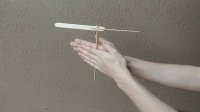R_Lefebvre
Arducopter Developer
Having the camera below the frame is done out of necessity. Obviously having the camera above the frame would not work for the application. But placing everything else, including the batteries below the frame is done, I believe, because of a mis-education and lack of understanding of physics. Not the other way around. Some people think this is more stable because the weight "hangs" from the props. But this isn't true, because the props are rigidly attached to the mass. If the camera has to be below the props, then it makes sense to put the batteries above. This will get closer to a neutral CG.
There is one frame design which allows the camera to be directly in line with the props. The batteries also. This results in a low moment of inertia which benefits stability.
There is one frame design which allows the camera to be directly in line with the props. The batteries also. This results in a low moment of inertia which benefits stability.

